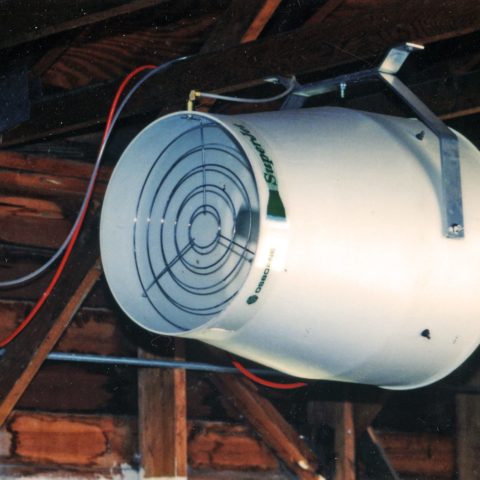
This blog is Part Two of our three-part series highlighting livestock ventilation system designs, with a focus on natural ventilation and mechanical ventilation. Read Part One here.
Livestock ventilation systems contribute not only to animal health, leading to a higher-quality finished product and better profitability, but also to the health of their caretakers. The type of ventilation system needed can depend on several factors, but there are two primary ways to ventilate livestock structures: natural ventilation and mechanical ventilation.
Natural & Mechanical Ventilation
While proper ventilation helps ensure higher production while keeping both animals and workers safe, there are varying methods for ventilating structures in which animals are kept. Essentially, livestock ventilation systems in barns and other structures fall into three categories:
- Natural: relies on wind and outside weather to moderate indoor environment.
Mechanical: involves mechanical devices to regulate indoor climate.
Hybrid: utilizes a combination of natural and mechanical methods.
Natural Ventilation
Natural ventilation techniques use less energy, though they tend to work better for older animals that can handle more drastic temperature fluctuations. Also called passive ventilation, it drives wind flow through openings in the structure, causing fresh air to blow naturally through the building.
Farmers raising larger animals that require confinement tend to utilize natural ventilation techniques, with sidewall and ridge openings promoting airflow through the building. Natural ventilation is often not adequate on its own, however, as temperatures and wind conditions outside vary, affecting airflow and temperature inside.
Mechanical Ventilation
Mechanical ventilation relies on fans to force air through the building, using thermostats and air inlets to control temperature and airflow throughout the structure. It allows livestock farmers to better control the environment regardless of climate or season. This is especially important when housing animals with sensitivity to abrupt temperature changes and in conditions that are cold or drafty.
Commonly, farmers use mechanical livestock ventilation for housing sows and pigs in gestation, farrowing, and nursery barns. Livestock farmers use fans to pull air into or push air out of the building. Circulation fans are also spaced throughout to provide more uniform conditions and eliminate any “dead air” spaces.
Several styles of mechanical ventilation are used by farmers, and the right choice is usually dependent on the overall climate and species housed in the barn. Systems are either positive pressure, where fresh air is forced into the barn, or negative pressure, where air is exhausted from the barn and fresh air is drawn through inlets. Many types of fans can be used to accomplish positive or negative pressure systems, like AGRI-AIDE Slant-Wall fans or Panel fans.
Mechanical livestock ventilation systems provide better control over both airflow and temperature. Their main disadvantage involves the expense of installation and operation compared to natural ventilation, though advancements in mechanical ventilation equipment and controls have significantly improved energy efficiency and overall operating costs. Mechanical ventilation also tends to improve food consumption by livestock, when compared to naturally ventilated structures.
Hybrid Ventilation
A combination of natural and mechanical ventilation techniques to limit moisture accumulating in winter and higher temperatures in summer are used for many kinds of growing livestock, especially for wean-to-finish or finishing barns for pigs. Balancing the heat and moisture coming off livestock changes quickly with those grown for meat production, as the larger the animal grows, the more moisture and temperature they throw off. Utilizing the benefits of both natural and mechanical ventilation can make for productive environments for growing animals.
Part Three: Chimney vs. Western-Style Technology
Follow along with our three-part series on livestock ventilation system designs. Our final blog will review the differences between chimney ventilation systems vs. Western-style mechanical livestock ventilation systems.
To learn more about Osborne Livestock Equipment and our products, including the Agri-Aide Ventilation System, please contact us today.



